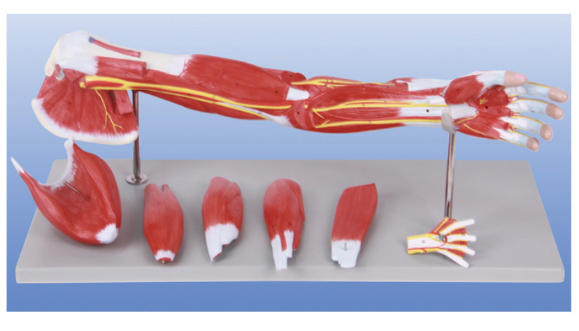Homepageпјҡ NEWS >> Is the anatomical model of upper limb muscle just a teaching aid or a practical bridge?
The role of the upper limb muscle anatomy model in medical education and clinical practice is much more than just a static teaching aid, it is more like a bridge between theory and practice, providing students and doctors with an important transition from book knowledge to practical practice.

The deepening of teaching AIDS
First of all, as a teaching aid, the anatomical model of upper limb muscle undoubtedly has a high teaching value. By precisely replicating the shape, structure and position of the upper limb muscles, it enables students to visually observe complex details that are difficult to fully display in books. This intuitiveness not only helps students quickly build an overall understanding of the upper limb muscle system, but also promotes a deeper understanding of muscle function, movement mechanisms, and interrelationships. In the anatomy course, the model has become a helpful assistant for teachers to explain and students to learn, which greatly improves the teaching effect and learning efficiency.
Bridge of practice
However, the value of anatomical models of upper limb muscles goes far beyond that. It is more like a bridge that connects theoretical knowledge with clinical practice. In medical education, theoretical knowledge is the foundation, but clinical practice is the real battlefield to test knowledge. The upper limb muscle anatomy model provides students with an opportunity to simulate a clinical environment, allowing them to practice in safe, controlled conditions. By touching, observing, analyzing and discussing the muscle structure on the model, students can gradually develop the ability to perceive and operate the real human structure. This practical ability will be critical for future clinical work, as it will help doctors make more confident and accurate diagnosis and treatment decisions in the face of real patients.
Stimulate exploration and innovation
In addition, the anatomical model of upper limb muscles also stimulated students' interest in learning and desire to explore. With the help of the model, students can further explore the mysteries of the upper limb muscle system and discover new problems and challenges. This spirit of exploration is one of the important driving forces for medical progress. At the same time, the model also provides a strong support for medical research and innovation. Scientists can use the model to conduct research on muscle function, movement mechanism, etc., and provide strong support for the development of new treatments.
In summary, anatomical models of upper limb muscles play multiple roles in medical education and clinical practice. It is a teaching aid to help students gain a deep understanding of the structure and function of the upper limb muscle system; It is also a practical bridge, connecting theoretical knowledge and clinical practice; At the same time, it is an important tool to stimulate students' desire to explore and innovative spirit. Therefore, we should fully recognize and utilize the value of the anatomical model of upper limb muscle to make greater contribution to the development of medical education and clinical practice.